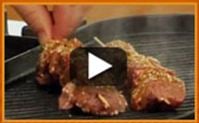 Summer is a season for simple pleasures—the smell of freshly cut grass, the warm sand on your toes at the beach, what-have-you. As far as dinner is concerned, it doesn't get more simple or pleasurable than grilled meat on a stick.
Summer is a season for simple pleasures—the smell of freshly cut grass, the warm sand on your toes at the beach, what-have-you. As far as dinner is concerned, it doesn't get more simple or pleasurable than grilled meat on a stick.
We're talking, of course, about kebabs, those colorful meat and veggie assemblages that originated in the Middle East and are also called "shish kebabs" (from the Turkish for "skewer" and "roast meat"). Traditionally made with lamb, they were the dish du jour among ancient nomadic tribes looking for sustenance. Today, they're a godsend for BBQ hosts who need something easy to cook so they can entertain, while sipping a cold beer.
You can use any kind of meat for kebabs, but if you want them to be as juicy and tender as possible, use Australian Lamb. In this easy-to-follow video, Chef Stephen shows you how it's done. You'll notice Chef cooks his North African-inspired kebabs indoors on a griddle, but the same simple instructions and tips apply when grilling outdoors. Be sure to check out our kebab grilling tips for additional information.
Prepare and Season
While many different cuts can be used for kebabs, Chef Stephen's pick is lamb rump (shank end of a leg of lamb). The lean cut takes well to spices and marinades. It's one of the best-value choices too.
As Chef instructs, you’ll want to buy a denuded rump, with sinew and fat removed. A regular serving size is around 6–8 ounces per person; cut the meat into 1-inch cubes for kebabs.
Not surprisingly, Middle Eastern spices are ideal for seasoning kebabs. Chef Stephen sprinkles and lightly presses each side of his kebabs with dukkah, a North African mix of ground sesame, cumin, coriander and pistachio. The mix can be found in the Middle Eastern section of most fine grocers, or try making your own (it's really easy). Either way, expect a beautifully nutty flavor.
After you've threaded your kebabs, brush both sides of the meat with olive oil. As you'll see, just a few brush strokes will do the trick, but this step is important because it will help prevent the meat from sticking to the grill.
Grill and Serve
Kebabs are best grilled over high heat, or, in Chef Stephen's case "a really hot griddle plate." Before cooking the meat, brush the griddle surface with olive oil, to keep it from sticking.
When cooking kebabs indoors, brush the grill surface with olive oil and keep the burner on high heat. Add the meat and allow about 3–4 minutes' cook time per side for medium rare. As Chef Stephen instructs, only turn the meat once (otherwise it will become dry and tough). Also avoid flipping the kebabs too soon, as the dukkah will stick to the grill.
Chef complements the North African flavors in the meat with Moroccan-style lemon couscous tossed with almonds, garnishing the whole package with mint, coriander and preserved lemon for an extra-fresh flavor kick. Give it a try, or have fun being creative with your own side dishes.

